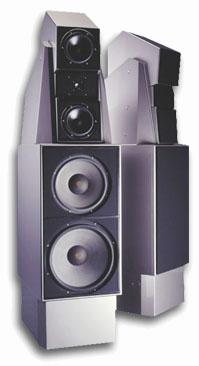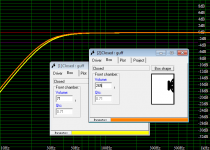What are the effects of using two drivers with differing T/S parameters in the same sealed sub-woofer enclosure?
(Qts: .40, .56; Vas: 149 l, 157 l; Fs: 16, 21)
(Qts: .40, .56; Vas: 149 l, 157 l; Fs: 16, 21)
What are the effects of using two drivers with differing T/S parameters in the same sealed sub-woofer enclosure?
(Qts: .40, .56; Vas: 149 l, 157 l; Fs: 16, 21)
Hi,
Quick answer:
Coupled oscillators.
http://physics-animations.com/Physics/English/bit_tmp.htm
Mechanics
Click on ?-mark at: Coupled oscillators.
Put your cursor over the picture with:Coupled spring oscillators. Beating effect.
Watch the effect.
Imagine the spring is the air-volume i a speaker-box, When both drivers are with different TS parameters fighting against the same air spring a beating effect occurs...The 'weaker' driver will suffer most.
b 🙂
Last edited:
Hi,
Its not a coupled oscillator due to the intrinsic damping if connected in parallel.
More details are really needed to ascertain if dividing the box evenly will help.
rgds, sreten.
Its not a coupled oscillator due to the intrinsic damping if connected in parallel.
More details are really needed to ascertain if dividing the box evenly will help.
rgds, sreten.
Can use single volume also!
Hi, Nestorovic and Modaferri did some interesting things with dissimilar drivers in the same volume.
Modaferri's 1983 patent in particular looks very interesting: by adding increasing phase shift to one of the drivers, starting with very little at ultra-low and gradually increasing to 180 degrees at higher, he was able to get up to +6dB more low bass when compared to a single driver or two in parallel in equivalent volume enclosures. He also was able to significantly reduce the impedance bump in the lows.
Have a look at the patent at
PAT2PDF - Free PDF copies of patents: Download and print!
It may come up with an error message, but when you conduct the search on 4403112 the info will come up. It's 21 pages of REALLY interesting work which directly addresses how to do it. And the patent has expired so we're all free to play with it.
I've previously done some 2.5 type enclosures with identical drivers but a lower freq roll-off on one driver. It worked better than predicted in the sims, with more extended bass than it was supposed to have. Now I know why! Turns out Modaferri covered a similar example in his patent and predicted much more bass extension with his models. I'll be trying something like his examples with larger phase shift real soon, looks like a great way to build subs.
Hi, Nestorovic and Modaferri did some interesting things with dissimilar drivers in the same volume.
Modaferri's 1983 patent in particular looks very interesting: by adding increasing phase shift to one of the drivers, starting with very little at ultra-low and gradually increasing to 180 degrees at higher, he was able to get up to +6dB more low bass when compared to a single driver or two in parallel in equivalent volume enclosures. He also was able to significantly reduce the impedance bump in the lows.
Have a look at the patent at
PAT2PDF - Free PDF copies of patents: Download and print!
It may come up with an error message, but when you conduct the search on 4403112 the info will come up. It's 21 pages of REALLY interesting work which directly addresses how to do it. And the patent has expired so we're all free to play with it.
I've previously done some 2.5 type enclosures with identical drivers but a lower freq roll-off on one driver. It worked better than predicted in the sims, with more extended bass than it was supposed to have. Now I know why! Turns out Modaferri covered a similar example in his patent and predicted much more bass extension with his models. I'll be trying something like his examples with larger phase shift real soon, looks like a great way to build subs.
Last edited:
There is already a name for a less elaborated variant : Double Driver Dynamic Loading for Low Q Drivers, or dddllqd.
some details are available in the Single Driver Website, but the link supposed revealing the theory is dead for me.
some details are available in the Single Driver Website, but the link supposed revealing the theory is dead for me.
The Wilson Audio X-1 had a 12" glass-fiber-reinforced pulp-cone upper woofer, and a 15" pulp-cone lower woofer in a single vented enclosure.


DDDL
@ Radugazon
RE - Double Driver Dynamic Loading for Low Q Drivers
And the dead link http://www.fortunecity.com/rivendell/xentar/1179/theory/dddllqd/dddllqd.html
I was able to retrieve it from the Wayback Machine http://web.archive.org/web/20050212...ndell/xentar/1179/theory/dddllqd/dddllqd.html 🙂
@ Radugazon
RE - Double Driver Dynamic Loading for Low Q Drivers
And the dead link http://www.fortunecity.com/rivendell/xentar/1179/theory/dddllqd/dddllqd.html
I was able to retrieve it from the Wayback Machine http://web.archive.org/web/20050212...ndell/xentar/1179/theory/dddllqd/dddllqd.html 🙂
The first time I advanced the original idea any number of professional speaker designers jumped up and told me flat out: "This WILL NEVER WORK".
Only Servodrive Inc's Tom Danley and Jean-Michel Le Cleac'h encouraged me and offered some assistance, so most what is written here is attributable more to those gentlemen than to myself.
DDDL
Hi,
The DDDL principle certainly works but uses drivers with wildly different
parameters. In this case without knowing driver sensitivities and Xmax
its not easy to say, but I imagine they won't be fine in the same box.
All depends on what they are and what your trying to do with them.
rgds, sreten.
Hi,
The DDDL principle certainly works but uses drivers with wildly different
parameters. In this case without knowing driver sensitivities and Xmax
its not easy to say, but I imagine they won't be fine in the same box.
All depends on what they are and what your trying to do with them.
rgds, sreten.
Attachments
- Status
- Not open for further replies.
- Home
- Loudspeakers
- Subwoofers
- Different drivers in same sealed cabinet
